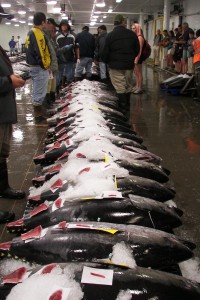To the fishermen there, 4:45 is sleeping in, and if any fishermen there heard me complain about our “early” start, I might have gotten a tuna in the face!
Today was the third day of our adventure out here in Hawaii and it was the earliest start yet….early for me that is and likely a few others in the group….4:45am. So early in fact that I drank coffee for the first time in years by 4 o’clock, if you call a caramel frappachino from Starbucks with whipped cream on top coffee!

Our early start was imperative as our destination was the tuna auction at the United Fishing Agency in downtown Honolulu, which begins before the sun comes up. To the fishermen there, 4:45 is sleeping in, and if any fishermen there heard me complain about our “early” start, I might have gotten a tuna in the face!
In all reality, I was too excited to be tired by the time we arrived. We were met by a former fishermen, current fleet owner, current West Pacific Fishery Management Council Member, and current Western/Central Pacific Management Commission member Sean Martin. He was gracious enough to spend the morning with us, giving us an invaluable understanding and appreciation of commercial long lining fisheries in Hawaii and on the High Seas.
Sean began by walking us around the busy dock along the wharf, where enormous 80ft long lining vessels had pulled up to port. They were already in the middle of offloading their catch. Cranes lifted large barrels full of fish, dumping them into large trailers, where each individual was unceremoniously gaffed and organized into orderly piles. Amongst the catch were many large big eye tunas, several marlins, a swordfish, mahi mahi, wahoo, and several local species. Once full, they were brought to the fish house, our next destination.

Before entering we were instructed to sanitize our shoes by walking through a shallow container of treated water. I couldn’t help but laugh to myself over the thought of cleaning my feet before entering a fish house of all places, but once inside I realized why. This was no ordinary smelly fish house. In fact, it didn’t stink at all! This was a place of serious business and where serious money is made. Quality is of the upmost importance, which I realized from several observations, (1) every fish was lain right next to one another on ice, perfectly ordered by size and species, (2) every tuna fish had samples of its own flesh on display for buyers to examine before they decided to purchase, and (3) the entire room felt like one enormous walk-in cooler!
Immediately upon entering the fish house I could hear and then see a large group of men, at least 15, bending over the big eye tunas. This was the auction in action! The auctioneer babbled prices until no one was willing the pay anymore per pound of fish than the last bidder. If I remember correctly, one fish, which weighed around 110 pounds was sold for about $600. Keep in mind that there were hundreds of these large tunas, which came through the doors of this fish house today. Amazingly, it took the group of buyers only about 30 – 40 minutes to move through at least 100 tunas, which was the catch from only one boat. Needless to say, I gained an appreciation for the sheer volume of fish that is moved through this market and the amount of money that is involved. Big eyes are big business in Hawaii and as Sean explained, they have a complicated management structure.

While big eyes can be caught within the Exclusive Economic Zone (EEZ) of the Hawaiian Islands, they are transboundary pelagic fishes. In other words, big eye tuna swim throughout the Pacific and are targeted by many other countries in international waters, otherwise known as the High Seas. Papua New Guinea, China, Russia, Micronesia, the Marshall Islands, and the U.S. are just a few of the countries pursuing big eyes in the High Seas.
In the U.S. EEZ, big eyes are managed under a hard total allowable catch (TAC), meaning the fishery shuts down once the quota is reached. The international fishery for big eyes in the High Seas are also managed under a hard TAC, which is determined and managed by the Western and Central Pacific Management Commission, an international body of which the U.S. is a party of. Each country is responsible for reporting their total catch to the commission. This is a point of contention as we learned from the assistant manager of the tuna auction. When I asked about how well other countries involved in the fishery monitor and report their catches, he laughed and said that we are the only one’s really monitoring our catch. He then proceeded to tell us to “hug academia while we can, once we get out into the real world, we have politics to deal with!”. I felt a little unnerved about graduation at that point, but much more informed about fisheries management in the High Seas!
